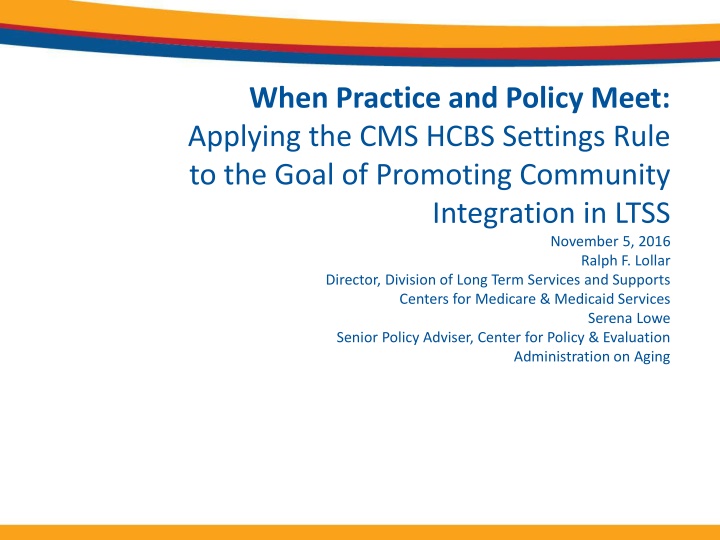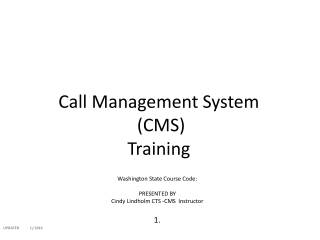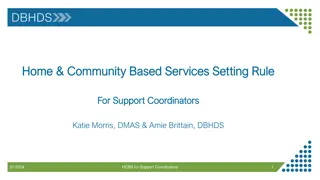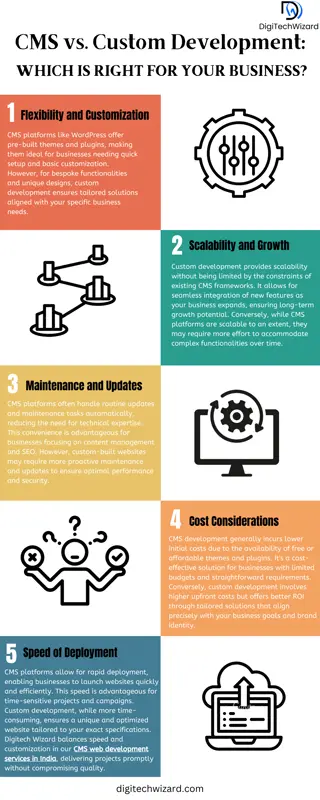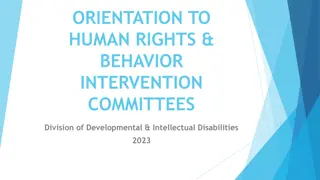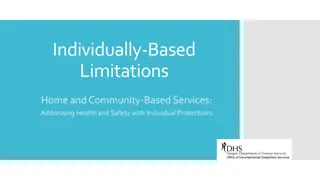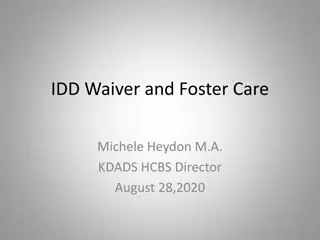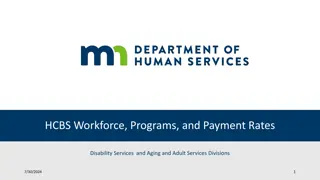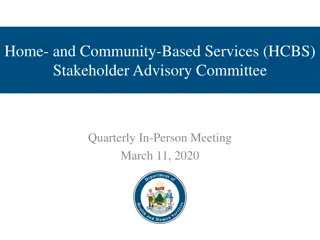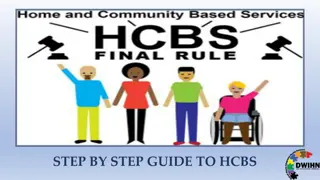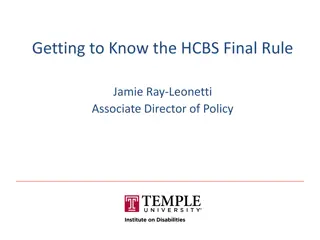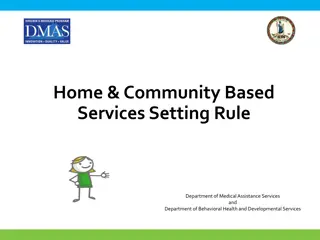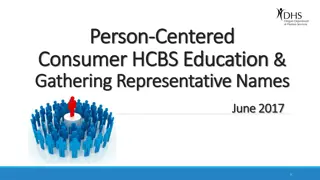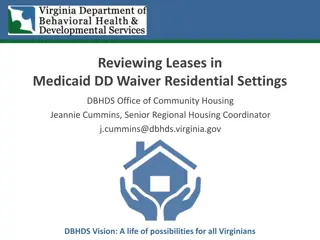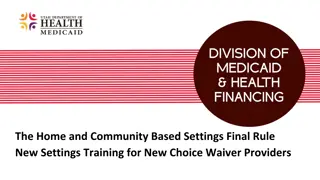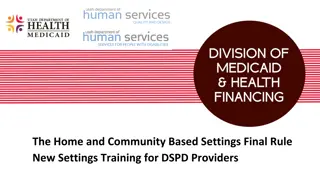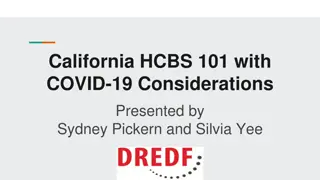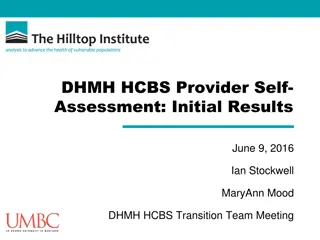Applying CMS HCBS Settings Rule to Promote Community Integration
The CMS HCBS Settings Rule aims to ensure individuals in LTSS programs have access to community living benefits. It emphasizes services in integrated settings, individual choice, and protection of rights. Provider-controlled residential settings have additional requirements. Specific guidelines for provider-owned or controlled units focus on legal agreements and eviction protections under tenant laws or written agreements at the state level.
Download Presentation

Please find below an Image/Link to download the presentation.
The content on the website is provided AS IS for your information and personal use only. It may not be sold, licensed, or shared on other websites without obtaining consent from the author.If you encounter any issues during the download, it is possible that the publisher has removed the file from their server.
You are allowed to download the files provided on this website for personal or commercial use, subject to the condition that they are used lawfully. All files are the property of their respective owners.
The content on the website is provided AS IS for your information and personal use only. It may not be sold, licensed, or shared on other websites without obtaining consent from the author.
E N D
Presentation Transcript
When Practice and Policy Meet: Applying the CMS HCBS Settings Rule to the Goal of Promoting Community Integration in LTSS November 5, 2016 Ralph F. Lollar Director, Division of Long Term Services and Supports Centers for Medicare & Medicaid Services Serena Lowe Senior Policy Adviser, Center for Policy & Evaluation Administration on Aging
Intent of the HCBS Settings Final Rule: CMS 2249-F and CMS 2296-F To ensure that individuals receiving long-term services and supports through home and community based service (HCBS) programs under the 1915(c), 1915(i) and 1915(k) Medicaid authorities have full access to benefits of community living and the opportunity to receive services in the most integrated setting appropriate. To enhance the quality of HCBS and provide protections to participants. Published in the Federal Register on January 16, 2014, under the title, Medicaid Program; State Plan Home and Community-Based Services, 5-year Period for Waivers, Provider Payment Reassignment, and Home and Community-Based Setting Requirements for Community First Choice (Section 1915(k) of the Act) and Home and Community Based Services (HCBS Waivers (Section 1915(c) of the Act) .
HCBS Setting Requirements Provides opportunities to seek employment and work in competitive integrated settings, engage in community life, and control personal resources Ensures the individual receives services in the community to the same degree of access as individuals not receiving Medicaid HCBS Is integrated in and supports access to the greater community Is selected by the individual from among setting options including non-disability specific settings and an option for a private unit in a residential setting Ensures an individual s rights of privacy, respect, and freedom from coercion and restraint Optimizes individual initiative, autonomy, and independence in making life choices Facilitates individual choice regarding services and supports and who provides them **Additional Requirements for Provider-Controlled or Controlled Residential Settings**
Home and Community-Based Setting Requirements: Provider-Owned or Controlled Specific unit/dwelling is owned, rented, or occupied under legally enforceable agreement Same responsibilities/protections from eviction as all tenants under landlord tenant law of state, county, city or other designated entity If tenant laws do not apply, state ensures lease, residency agreement or other written agreement is in place providing protections to address eviction processes and appeals comparable to those provided under the jurisdiction s landlord tenant law
Home and Community-Based Setting Requirements: Provider-Owned or Controlled (2) Each individual has privacy in their sleeping or living unit Units have lockable entrance doors, with appropriate staff having keys to doors as needed Individuals sharing units have a choice of roommates Individuals have the freedom to furnish and decorate their sleeping or living units within the lease or other agreement Individuals have freedom and support to control their schedules and activities and have access to food any time Individuals may have visitors at any time Setting is physically accessible to the individual
Home and Community-Based Setting Requirements: Modifications of Provider-Owned or Controlled Modifications of the additional requirements must be: Supported by specific assessed need Justified in the person-centered service plan Documented in the person-centered service plan
Home and Community-Based Setting Requirements: Modifications of Provider-Owned or Controlled (2) Documentation in the person-centered service plan of modifications of the additional requirements includes: Specific individualized assessed need Prior interventions and supports including less intrusive methods Description of condition proportionate to assessed need Ongoing data measuring effectiveness of modification Established time limits for periodic review of modifications Individual s informed consent Assurance that interventions and supports will not cause harm
Distinguishing between Settings under the HCBS Rule Nursing Facilities Institution for Mental Diseases (IMD) Intermediate care facility for individuals with I/DD (ICF/IID) Hospitals Settings that are not HCB Settings in a publicly or privately-owned facility providing inpatient treatment Settings on grounds of, or adjacent to, a public institution Settings with the effect of isolating individuals receiving Medicaid HCBS. Settings presumed not to be HCB Settings that are HCB but do not comport with one or more of the specific requirements outlined in the final rule. May require modifications at an organizational level, and/or modifications to the PCP of specific individuals receiving services within the setting. Must engage in remediation plan with the state, and complete all necessary actions no later than March 2019. Settings that could meet the HCB rule with modifications Settings presumed to be HCB and meet the rule without any changes required Individually-owned private homes Individualized supported employment Individualized community day activities
Settings that are NOT Home and Community-Based Nursing facility Institution for mental diseases (IMD) Intermediate care facility for individuals with intellectual disabilities (ICF/IID) Hospital
Settings PRESUMED NOT to Be Home and Community-Based Settings in a publicly or privately-owned facility providing inpatient treatment Settings on grounds of, or adjacent to, a public institution Settings with the effect of isolating individuals from the broader community of individuals not receiving Medicaid HCBS
Settings PRESUMED NOT to Be Home and Community-Based (2) These settings may NOT be included in states 1915(c), 1915(i) or 1915(k) HCBS programs unless: A state submits evidence (including public input) demonstrating that the setting does have the qualities of a home and community-based setting and NOT the qualities of an institution; AND The Secretary finds, based on a heightened scrutiny review of the evidence, that the setting meets the requirements for home and community-based settings and does NOT have the qualities of an institution
HCBS Residential Settings: Considerations 1. 2. The setting was selected by the individual. The individual participates in unscheduled and scheduled community activities in the same manner as individuals not receiving Medicaid HCBS services. The individual is employed or active in the community outside of the setting. The individual has his/her own bedroom or shares a room with a roommate of choice. The individual chooses and controls a schedule that meets his/her wishes in accordance with a person-centered plan. The individual controls his/her personal resources. The individual chooses when and what to eat. The individual chooses with whom to eat or to eat alone. 3. 4. 5. 6. 7. 8.
HCBS Residential Settings: Considerations (2) 9. Individual choices are incorporated into the services and supports received. 10.The individual chooses from whom they receive services and supports. 11.The individual has access to make private telephone calls/text/email at the individual s preference and convenience. 12. Individuals are free from coercion. 13. The individual, or a person chosen by the individual, has an active role in the development and update of the individual s person-centered plan. 14. The setting does not isolate individuals from individuals not receiving Medicaid HCBS in the broader community. 15. Do individuals receiving HCBS live/receive services in a different area of the setting?
HCBS Residential Settings: Considerations (continued) 16.State laws, regulations, licensing requirements, or facility protocols or practices do not limit individuals choices. 17.The setting is an environment that supports individual comfort, independence and preferences. 18.The individual has unrestricted access in the setting. 19.The physical environment meets the needs of those individuals who require supports. 20.Individuals have full access to the community. 21.The individual s right to dignity and privacy is respected. 22.Individuals who need assistance to dress are dressed in their own clothes appropriate to the time of day and individual preferences. 23.Staff communicates with individuals in a dignified manner.
HCBS Non-Residential Settings: Considerations [Reference: CMS Exploratory Questions] Is the setting physically accessible, including access to bathrooms and break rooms, and are appliances, equipment, and tables/desks and chairs at a convenient height and location, with no obstructions such as steps, lips in a doorway, narrow hallways, etc., limiting individuals mobility in the setting? If obstructions are present, are there environmental adaptations such as a stair lift or elevator to ameliorate the obstructions? Is the setting in the community/building located among other residential buildings, private businesses, retail businesses, restaurants, doctor s offices, etc. that facilitates integration with the greater community? Does the setting allow individuals the freedom to move about inside and outside of the setting as opposed to one restricted room or area within the setting? For example, do individuals receive HCBS in an area of the setting that is fully integrated with individuals not receiving Medicaid HCBS? Are there gates, Velcro strips, locked doors, fences or other barriers preventing individuals entrance to or exit from certain areas of the setting?
HCBS Non-Residential Settings: Considerations (2) [Reference: CMS Exploratory Questions] Does the setting reflect individual needs and preferences and do its policies ensure the informed choice of the individual? Was the individual provided a choice regarding the services, provider and settings and the opportunity to visit/understand the options? Does the setting ensure individuals are supported to make decisions and exercise autonomy to the greatest extent possible? Does the setting afford a variety of meaningful non-work activities that are responsive to the goals, interests and needs of individuals, and also for the period of time desired by the individual? Does the setting afford opportunities for individuals to choose with whom to do activities in the setting or outside the setting or are individuals assigned only to be with a certain group of people? Does the setting post or provide information on individual rights?
HCBS Non-Residential Settings: Considerations (3) [Reference: CMS Exploratory Questions] Does the setting support individuals who need assistance with their personal appearance to appear as they desire, and is personal assistance, provided in private, as appropriate? Does the setting assure that staff interact and communicate with individuals respectfully and in a manner in which the person would like to be addressed, while providing assistance during the regular course of daily activities? Do setting requirements assure that staff do not talk to other staff about an individual(s) in the presence of other persons or in the presence of the individual as if s/he were not present? Does the setting prohibit individuals from engaging in legal activities (ex. voting consuming alcohol) in a manner different from individuals in similar and/or the same setting who are not receiving Medicaid funded services and supports? Does the setting policy require that the individual and/or representative grant informed consent prior to the use of restraints and/or restrictive interventions and document these interventions in the person-centered plan?
HCBS Non-Residential Settings: Considerations (4) [Reference: CMS Exploratory Questions] Does the setting afford opportunities for individuals to have knowledge of or access to information regarding age-appropriate activities including competitive work, shopping, attending religious services, medical appointments, dining out, etc. outside of the setting, and who in the setting will facilitate and support access to these activities? Does the setting provide individuals with contact information, access to and training on the use of public transportation, such as buses, taxis, etc., and are these public transportation schedules and telephone numbers available in a convenient location? Alternatively where public transportation is limited, does the setting provide information about resources for the individual to access the broader community, including accessible transportation for individuals who use wheelchairs? Does the setting offer a secure place for the individual to store personal belongings?
HCBS Non-Residential Settings: Considerations (5) [Reference: CMS Exploratory Questions] Does the setting encourage visitors or other people from the greater community (aside from paid staff) to be present, and is there evidence that visitors have been present at regular frequencies? For example, do visitors greet/acknowledge individuals receiving services with familiarity when they encounter them, are visiting hours unrestricted, or does the setting otherwise encourage interaction with the public? Does the setting allow for individuals to have a meal/ snacks at the time and place of their choosing? For instance, does the setting afford individuals full access to a dining area with comfortable seating and opportunity to converse with others during break or meal times, afford dignity to the diners (i.e., individuals are treated age-appropriately and not required to wear bibs)? Does the setting provide for an alternative meal and/or private dining if requested by the individual? Do individuals have access to food at any time consistent with individuals in similar and/or the same setting who are not receiving Medicaid-funded services and supports?
Transition Plans Transition Plans o For 1915(c), 1915(i) and 1915(k) programs/services in effect prior to March 17, 2014 o Includes 1115 Demonstrations and 1915(b)(3) services o Only apply to settings Note: New 1915(c), 1915(i) and 1915(k) programs and settings on or after March 17, 2014 must be in full compliance with HCB settings regulations at the time of approval.
Statewide Plan Elements Evidence of the public notice process and results Systemic regulation and policy assessment HCB Settings assessment including settings presumed institutional in nature Remediation (systemic and settings specific) Proposed remedial strategies and timelines Monitoring to assure ongoing compliance Plan to assist individuals who may need to transition to another provider
Review of HCBS Settings under Final Rule: Key Components Assessment Validation Remediation
Settings Assessment for HCBS Compliance: Threshold States are responsible for assuring that 100% of all HCBS settings comply with 100% of the final HCBS rule in its entirety. Quality thresholds should not be used to reduce the state s requirement to assure 100% compliance across all settings.
HCBS Compliance in both Residential & Non-Residential Settings Individuals receiving HCB services must reside in settings that comply fully with the rule (regardless of whether those settings are being paid for using HCBS funds or not). Living in HCB settings that do not comply with the rule could jeopardize an individual s ability to receive non-residential HCBS.
HCBS Implementation with Integrity: Emerging Issues Large congregate, facility-based settings should be carefully reviewed to determine whether they are presumptively institutional and/or identify remediation required to comply with the rule. Availability of single-units and roommate choices Unrestricted access to visitors, food and individual schedules Locked Units/Delayed Egress Control over personal resources
HCBS Implementation with Integrity: Emerging Issues (2) Where you live AND where you spend your day MATTERS under the HCBS rule. How much Integration is Enough? Reverse Integration does not equal community integration, and this strategy by itself will not result in an appropriate level of compliance with the rule. Implications of waiver/state plan service definitions and reimbursement structures
Implementation with Integrity: Priority Areas of Emphasis in Aging Settings Person-Centered Planning Strategies for Community Integration in both Residential & Non Residential Capacity Building/Training & TA Heightened Scrutiny Settings that Isolate Wandering & Exit Seeking Behaviors/Memory Care Planned Construction Conflict of Interest
Person-centered planning A key requirement for Medicaid HCBS providers Required effective 3-17-2014 Providers who have focused on implementing strong person-centered planning practices can be valuable to show how it can be done.
Person Centered Planning in the Context of HCBS Individual Preferences Innovation in Supports & Use of Technology Leveraging of Natural & Paid Supports Person- Centered Plan Flexibility in Scheduling
Serena Lowe, PhD Senior Policy Adviser, Administration on Community Living IMPLEMENTING THE HCBS RULE & PROMISING PRACTICES FOR WANDERING & EXIT-SEEKING BEHAVIOR
Wandering Wandering can be helpful or dangerous, depending on the situation. People may wander in response to: An unmet basic need like human contact, hunger, or thirst Boredom or a noisy, confusing environment Some type of distress, like pain or the need to use the toilet. People who wander may gain social contact, exercise, and stimulation OR, they can become lost or exhausted.
Person-Centered Services & Wandering/Exit-seeking in Community Settings (1) Key response is person-centered services. Person-centered service planning involves knowing people, their needs, preferences, and history, which helps service providers anticipate ways to meet needs and prevent injury for those who wander. Literature review concluded that, Person-centered interventions are associated with positive influences on staff outcomes & improvement in the psychological status of residents and reduced agitation.
Person-Centered Services & Wandering/Exit-seeking in Community Settings (2) Service providers are likely to provide better services and supports when they: Know the personal history of the individual with wandering/exit-seeking behavior Know the person s current health condition and remaining abilities Know the situations or unmet needs that historically have triggered wandering/exit-seeking, their history and background Try approaches to addressing wandering/exit-seeking that respond to the person s unique circumstances and needs.
Person-centered Service Plan Goals when Wandering/ Exit-seeking Occurs Service plan goals are to: Encourage, support, and maintain a person s mobility and choice, enabling him or her to move about safely and independently Ensure that causes of wandering/exit-seeking are assessed and managed, with particular attention to unmet needs Prevent unsafe wandering/exit-seeking.
Practice Recommendations (1) The research and practice literature recommends specific approaches to responding to wandering/exit-seeking. They generally involve the following: Assessing the patterns, frequency, and triggers for wandering/ exit-seeking through observation and talking with people who have these behaviors and their families or friends Using this baseline information to develop a person-centered service plan to address these triggers, implement the plan, and measure its impact Using periodic assessments to update information about a person s wandering/exit-seeking and adjust the person- centered service plan as necessary.
Practice Recommendations (2) Using environmental design and other strategies to address unsafe wandering/exit-seeking, for example: Eliminating overstimulation, such as visible doors that people use frequently; noise; and clutter Preventing under-stimulation by offering activities that engage interest. Activities could include music, art, physical exercise, mental stimulation, therapeutic touch, pets, or gardening Providing a safe, uncluttered path for people to wander that has points of interest and places to rest Using signage to orient the individual to the environment, such as indicating location of toilets and bedrooms Disguising exit doors using murals, if safety codes permit.
Practice Recommendations (3) Using technological solutions as part of a person-centered service plan to alert others so that they can reduce the risks of wandering/exit-seeking. Recommending that people who may wander/exit-seek unsafely carry identification with their name and the service provider s location and contact information. Using Silver Alert systems in those states that have them.
Practice Recommendations (4) Police departments may have registries where, with permission, people can fill out a short form, so if a person wanders, officers can find out how best to communicate with him or her, and get other important information. Creating a lost-person plan that describes staff and safety personnel s roles and responsibilities when an individual has exited unsafely. Evaluating each lost-person incident to make revisions to person-centered service plans or to environmental design as necessary.
Practice Examples from the Field (1) Help the person feel comfortable in new settings and monitor them closely for a few weeks, if they are at risk of wandering/exit-seeking. Distract the individual at risk of unsafe wandering/exit- seeking with something he or she enjoys (e.g., rocking in a rocking chair, reading, eating ice cream) rather than saying no. Support opportunities for safe wandering. Circular paths with benches and railings for rest and balance can help. They can: Be indoors and outdoors Be free of trip hazards Have discreet visual shields/distractions/barriers/silent alarms.
Practice Examples from the Field (2) Be aware of cues for exiting and use strategies to address them: Engage the person in meaningful activities after meals Distract the person at times of shift change Post signs at doors asking visitors not to leave with anyone other than the person they came with or asking them to alert staff when they leave so the exit can be monitored. Use of webcams or closed-circuit TVs at exits, especially those exits that staff cannot easily observe. Note that providers generally need to get permission from staff and a sign must be posted about the presence of the webcam or TV.
Practice Examples from the Field (3) Adequate supervision may vary from resident to resident and from time to time for the same resident. The following tools can help to monitor a resident s activities, but do not eliminate the need for adequate supervision: Use silent alarms to alert staff if a person who tends to wander/exit-seek enters a risky area Use medical ID bracelets, when they are part of a person- centered service plan, so emergency personnel know whom to call if they find a person who has exited unsafely.
Practice Examples from the Field (4) Clearly label important doors: Shadowboxes or collages with personal items on the door to people s rooms Photos of a toilet could be a reminder of the bathroom Frosting of glass doors or windows can reduce a person s ability to look out. Make sure this complies with fire/safety codes. Many states will permit window locks so the window cannot be opened more than 6 inches.
Person-Centered Services & Wandering Resources (2) UNC and CEAL s Toolkit for Person-Centeredness in Assisted Living An Informational Guide and Questionnaires of Person-centered Practices in Assisted Living (PC-PAL) available at http://www.shepscenter.unc.edu/news_release/new-free- questionnaires-can-improve-care-quality-life-older-adults-assisted- living-person-centered-practices/ The Down Syndrome Society has information at: http://www.ndss.org/Resources/Aging-Matters/Alzheimers-Disease Practice recommendations for people with Down syndrome from the National Task Group on Intellectual Disabilities and Dementia Practices: http://aadmd.org/ntg The National Autism Association has a safety-related site at: http://nationalautismassociation.org/resources/naas-autism- safety-site/
HCBS in Non-Residential Settings: Promoting Community Integration Availability of supports to allow a person to engage in the broader community for the maximum number of hours desired daily. Activities designed to maximize independence, autonomy and self-direction. Access Broad range of activities/offerings that are comparable to those in which individuals not receiving HCBS routinely engage. Access to both individualized and small-group activities, on and off site. Variety Cultural competency Measurement focused on Increasing Community Access, Decreasing Social Isolation Quality
HCBS in Non-Residential Settings for Aging Beneficiaries: Promising Practices (1) Finding out during initial assessments what individuals desire in terms of community engagement and educate them about how the setting s capabilities will meet the individual s needs and preferences. Documenting the factors the person identifies as important in a community such as proximity to and involvement of family, connections to communities of faith, specific cultural resources and activities, and others. Recording individual preferences for community integration in the person-centered plan and how the setting will support those preferences (e.g., participating in their faith community, attending a favorite club, Sunday breakfast at the local diner, interests in volunteering or in working, etc.) as well as the human support and transportation needed to achieve desired outcomes.
HCBS in Non-Residential Settings for Aging Beneficiaries: Promising Practices (2) Providing individuals with opportunities to engage with both HCBS beneficiaries and individuals not receiving HCBS in the setting through activities, outings, and socialization opportunities. Design of multiple daily activities and access to the broader community through a combination of natural supports, formal community partnerships, and formal programming that allows for each individual to be able to select from an array of individual and/or group options and control his or her own schedule. Provision of services in a culturally competent way, with options that meet the needs of diverse populations such as limited-English proficient older adults.
HCBS in Non-Residential Settings for Aging Beneficiaries: Promising Practices (3) Reaching out to local businesses and community partners to request program/activity/event discounts and free memberships for individuals receiving HCBS similar to offerings provided to other special populations. Exhausting natural supports and public transportation options (including ride shares, taxi services, public metro or bus systems, trains, virtual transportation services, etc) to promote optimal individualization of scheduling and activities. Fostering access to technology, virtual applications, and other innovations as a way to stimulate natural supports and provide solutions-oriented strategies to facilitate greater participation in activities by HCBS beneficiaries in the broader community.
HCBS in Non-Residential Settings for Aging Beneficiaries: Promising Practices (4) Providing natural and HCBS supports to enable individuals exploration of and participation in their activities of choice in the broader community. These may include opportunities for work, cultural enjoyment, worship, or volunteering. Ensuring individuals can connect to their virtual communities of choice through social media noting that this alone does not substitute for community activities and integration. Ensuring that individuals have opportunities to visit with and go out with family members and friends, when they want this. Providing an inviting environment and flexible schedules and service times (e.g., meals, medication administration) can encourage family and friends participation in the life of the residential setting and support their efforts to maintain individuals connections to the external community.
CMS HCBS Resources http://www.medicaid.gov/HCBS Main CMS HCBS Website: http://www.medicaid.gov/HCBS http://www.medicaid.gov/medicaid-chip-program-information/by-topics/long-term-services-and-supports/statewide-transition-plan-toolkit.pdf http://www.medicaid.gov/medicaid-chip-program-information/by-topics/long-term-services-and-supports/statewide-transition-plan-toolkit.pdf Final Rule & Sub-regulatory Guidance http://www.medicaid.gov/medicaid-chip-program-information/by- topics/long-term-services-and-supports/statewide-transition-plan- toolkit.pdf A mailbox to ask additional questions (hcbs@cms.hhs.gov) Exploratory Questions Residential Settings Non-Residential Settings FAQs HCBS FAQs on Heightened Scrutiny dated 6/26/2015 FAQs on Settings that Isolate Incorporation of HS in the Standard Waiver Process http://www.medicaid.gov/medicaid-chip-program-information/by-topics/long-term-services-and-supports/statewide-transition-plan-toolkit.pdf http://www.medicaid.gov/medicaid-chip-program-information/by-topics/long-term-services-and-supports/statewide-transition-plan-toolkit.pdf Residential Settings Non-Residential Settings HCBS FAQs on Heightened Scrutiny FAQs on Settings that Isolate Incorporation of HS in the Standard Waiver Process
Other HCBS Resources ACL Plain-Spoken Briefs on HCBS Rule & Person http://www.acl.gov/Programs/CPE/OPAD/HCBS.aspx Centered Planning: http://www.acl.gov/Programs/CPE/OPAD/HCBS .aspx http://www.acl.gov/Programs/CPE/OPAD/HCBS.aspx Advocacy Toolkit http://hcbsadvocacy.org/ http://hcbsadvocacy.org/
